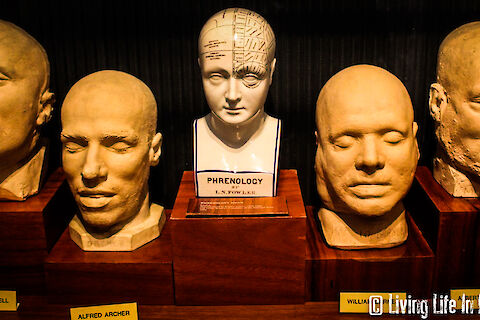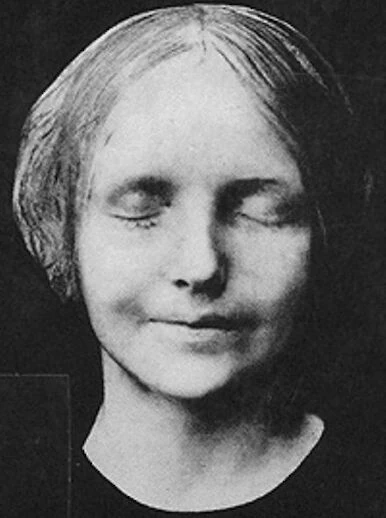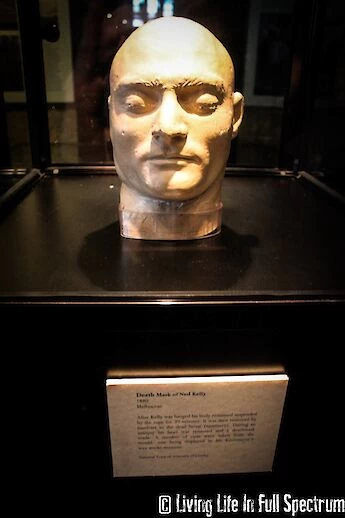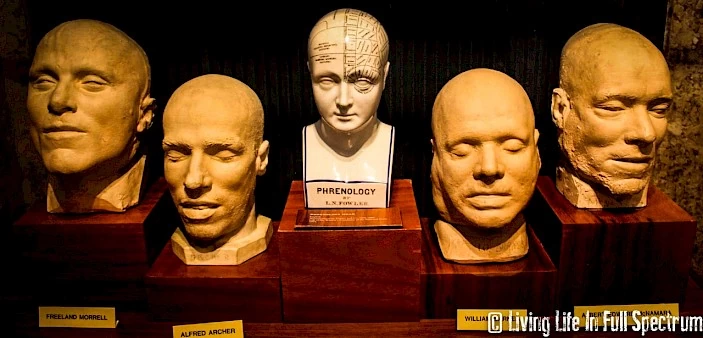

Death masks and the study of phrenology
When roaming the halls of what was once a gaol, it is not uncommon for there to be displays and stories of former inmates. What is particularly unnerving, is when they have on display a death mask. The Old Melbourne Gaol in Victoria is full of them. So what is a death mask and why would you cast a mask of someone who was executed?
Death Masks
In some ancient cultures, they used what were called funeral masks as part of the rituals they would perform when burying a body. In Ancient Egypt for example, they would mummify the body and put it into a sarcophagus which was decorated with various jewels. The finishing touch to this which was considered to be a very important sacred element was to put a sculpted mask on the face of the deceased. It was believed that the mask would strengthen the spirit of the mummy and guard it against evil on its way to the afterworld.

Nikola Tesla Image Source: Tesla Universe
In the late 1880s, the process of casting death masks was used as a way to help identify the body of a missing person. If an unidentified body was presented, a mask was taken so that family members looking for missing people could identify the body. Remember this is long before the technology we have today. There is, in particular, one mask which is known as L’Inconnue de la Seine. It was the face of an unidentified young woman who had been found drowned at the Seine River in Paris sometime in the 1880s. She was believed to be around 16 years old. The morgue worker who cast the mask was ‘bewitched’ by her beauty. The mask because quite popular and considered almost of a work of art. The world’s first CPR mannequin was modelled after this mask.

L'Inconnue de la Seine Image Source: Public Domain
In the 19th Century and early 20th Centuries. The process of death masks was used widely on inmates in prisons after they were executed. After they were hung, their head would be shaved, and a cast of their head would be taken. The intention of this was not solely to display the masks in a museum (even though that is what they are doing today). They were to be unknowing participants in a study called Phrenology.
Phrenology
Phrenology is considered to be a pseudo-medicine that is no longer practised as it has since been scientifically discredited. It was developed in 1796 by German physician Franz Joseph Gall. In 1820, the Edinburgh Phrenological Society was established. The process behind Phrenology involves feeling and observing the measurements of a human skull. The belief was that certain behaviours and traits were confined to different sections of the brain. It was believed there were around 27 different sections of the brain. A phrenologist would run their fingertips and palms over a person’s skull to see if they could feel any enlargements or indentations or simple terms - feel the bumps. They would measure the head. From these finds, a Phrenologist would assess the character and the temperament of the patient. There were considered to be 5 fundamental points to phrenology:
- The brain is the organ of the mind.
- The mind is composed of multiple, distinct, innate faculties.
- Because they are distinct, each faculty must have a separate seat or "organ" in the brain.
- The size of an organ, other things being equal, is a measure of its power.
- The shape of the brain is determined by the development of various organs.
- As the skull takes its shape from the brain, the surface of the skull can be read as an accurate index of psychological aptitudes and tendencies.
By around the 1840s, Phrenology had been discredited as a Scientific Theory based on a large amount of evidence against the concept. It was in the early 20th century that the concept became popular again. It was during this resurgence that it was thought a criminal could perhaps be rehabilitated. A diagnosis could be made and a plan put in place to help to rehabilitate the criminal. For example, a criminal with homicidal tendencies became a butcher in order to control his impulses. Somewhere along the way in this study, prisons would start to cast death masks on inmates who had been executed.
Death Masks of Criminals
In the 19th Century, the practice of casting a death mask of an inmate who had been executed was quite widespread. They were not only used for the study of phrenology but also appeared in museums and material for prison authorities to use for lectures and as a deterrent for people – if you do the crime, this is what could happen to you. It was even said to be a source of entertainment for those who worked in prisons. Ned Kelly's Deathmask is one of the most famous on display at the Old Melbourne Gaol. It is not however the original death mask, it is a copy. It was not uncommon for copies to be made as they are quite fragile.

Ned Kelly's Death Mask (copy) on display at Old Melbourne Gaol
Old Melbourne Gaol's Death Masks
One of the biggest collections of death masks in Australia is held by the Old Melbourne Gaol. There is an extensive collection of original death masks and some of which are copies. What is eerie about these masks is the expression on the faces of the subjects. They all met their fate by hanging at the gaol. Some seem at peace. Others have a look of distress while one seems to have a smirking smile. In some cases, you can see the contortion in the neck from where they were hung and even little hairs sticking out from the plaster. One has to wonder if the energy of the person and the trauma associated with their death is embedded within the masks.

This is just another example of how our strange past and intrigue with macabre things fascinate us still to this day. I know I can’t be around a death mask for long. Whether I am feeling the energy of the mask or I am just a little bit creeped out, it doesn’t sit well with me.
Photos by Sarah LLIFS
If you enjoy LLIFS, consider buying me a book (otherwise known as buy me a coffee but I don't drink coffee and I LOVE books). Your donation helps to fund the LLIFS website so everyone can continue to access great paranormal content and resources for FREE!

Top pages with similar subjects
Don't forget to follow the Facebook page for regular updates
Join the mailing list to receive weekly updates of NEW articles. Never miss an article again!
Buy the latest and past issues Haunted Magazine
Check out the books written by LLIFS
Comments
-
Randal 4 years ago
I'll immediately snatch your rss feed as I can't to find your email
subscription link or e-newsletter service.Thanks. Wow, this piece of writing is nice, my sister
is analyzing these things, thus I am going to convey her.
I’ve been browsing online more than 4 hours
today, yet I never found any interesting article like yours.
It’s pretty worth enough for me. Personally, if all web owners and bloggers made
good content as you did, the internet will be a lot more useful than ever before.